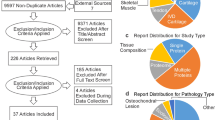Abstract
The aim of this study was to analyze the presence and distribution of total collagen, type I and type III collagen, elastic fibers, fibronectin, and versican in the endomysium of cricopharyngeus muscles from adults of various ages. The study was a cross-sectional analysis of human cricopharyngeus muscles. Twenty-seven muscles obtained from autopsies of men and women ranging in age from 28 to 92 years were analyzed with the Picrosirius method, oxidized Weigert resorcin-fuchsin, immunohistochemistry, and image analysis. Collagen had the highest density among the analyzed components. Elastic fibers surrounded each muscle cell; they were aligned longitudinally by their long axis and associated with traversing fibers, thereby forming a fiber network with embedded muscle cells. The fibronectin and versican contents varied widely among the specimens. We found no statistically significant differences between the proportion of extracellular matrix (ECM) components and factors such as gender and race. We conclude that the higher proportion of type I and type III collagen is compatible with the cricopharyngeus muscle’s sphincteric behavior, and the arrangement of the elastic fibers may also contribute to the muscle’s elasticity. We found no statistically significant correlation between the ECM components and age.

Similar content being viewed by others
References
Goyal RK, Martin SB, Shapiro J, Spechler SJ. The role of the cricopharyngeus muscle in pharyngoesophageal disorders. Dysphagia. 1993;8:252–8.
Sivarao DV, Goyal RJ. Functional anatomy and physiology of the upper esophageal sphincter. Am J Med. 2000;108(4A):27(S)–37(S).
Kristmundsdottir F, Mohon M, Froes MMQ, Cumming WJK. Histomorphometric and histopathological study of the human cricopharyngeus muscle in health and in motor neuron disease. Neuropathol App Neurobiol. 1990;16:461–75.
Bonington A, Mahon M, Whitmore I. A histological and histochemical study of the cricopharyngeus muscle in man. J Anat. 1988;156:27–37.
Laurikainen E, Aitasalo K, Halonen P, Falck B, Kalimo H. Muscle pathology in idiopathic cricopharyngeus dysphagia. Enzyme histochemical and electron microscopic findings. Eur Arch Otorhinolaryngol. 1992;249:216–23.
Kelly JH, Kencl RW. Myology of the pharyngoesophageal segment: gross anatomy and histologic characteristics. Laryngoscope. 1996;106:713–20.
Cruse JP, Edwards DAW, Smith JF, Wyllie JH. The pathology of cricopharyngeal dysphagia. Histopathology. 1979;3:223–32.
Browlow H, Whitemore I, Willian PLT. A quantitative study of the histochemical and morphometric characteristics of the human cricopharyngeus muscle. J Anat. 1989;166:67–75.
Montes GS. Structural biology of the fibers of the collagenous and elastic systems. Cell Biol Int. 1996;20(1):15–27.
Bradbury P, Rae K. Connective tissue and stains. In: Bancroft JD, Steves A, editors. Theory and practice of histological techniques. 4th ed. New York: Churchill Livingstone; 1996. p. 113–38.
Araújo BB, Dolhnikoff Silva LF, et al. Extracellular matrix components and regulators in the airway smooth muscle in asthma. Eur Res J. 2008;32(1):61–9.
Shaker R, Kern M, Bardan E, et al. Augmentation of deglutitive upper esophageal sphincter opening in the elderly by exercise. Am J Physiol. 1997;272:1518–22.
Järvinen TA, Józsa L, Kannus P, et al. Organization and distribution of intramuscular connective tissue in normal and immobilized muscles. J Musc Res Cell Motil. 2002;23:245–54.
Kovanen V. Effects of ageing and physical training on rat skeletal muscle. Acta Physiol Scand Suppl. 1989;577:1–56.
Light N, Champion AE. Characterization of muscle epimysium, perymisium and endomysium collagens. Biochem J. 1984;219:1017–26.
Goyal RJ, Sinvarao DV. Functional anatomy and physiology of swallowing and esophageal motility. In: Castell DO, Richter JE, editors. The esophagus. Philadelphia: Lippincott Williams & Wilkins; 1999. p. 1–31.
Ross R. The elastic fiber. J Histochem Cytochem. 1973;21(3):199–208.
Hynes RO, Yamada KM. Fibronectins: multifunctional modular glycoproteins. J Cell Biol. 1982;95:369–77.
Gulati AK, Reddi AH, Zlewski AA. Distribution of fibronectin in normal and regenerating skeletal muscle. Anat Rec. 1982;204:175–83.
Buhler RB, Sennes LU, Mauad T, et al. Collagen fiber and versican distribution with the lamina propria of fetal vocal folds. Laryngoscope. 2007;117:1–4.
Fomovsky GM, Thomopouulos S, Holmes JW. Contribution of extracellular matrix to the mechanical properties of the heart. J Mol Cel Cardiol. 2010;48(3):490–6.
Souza RR. Aging of myocardial collagen. Biogerontology. 2002;3:325–35.
Puff A, Langer H. Das Problem der diastolischen Entfaltung der herzkammer (Eine Untersuchung eber das elastichen Gewebe im Myocard). Gegenbaurs Morphol Jahrb. 1965;107:184.
Farahnaz F, Contard F, Corbier A, et al. Fibronectin expression during physiological and pathological cardiac growth. J Mol Cel Cardiol. 1995;27(4):981–90.
Rodrigues CJ, Rodrigues Júnior AJ. A comparative study of aging of the elastic fibers system of the diaphragm and the rectus abdominis muscles in rats. Braz J Med Biol Res. 2000;33(12):1449–54.
Acknowledgments
We thank the autopsy assistants of the SVOC-USP who helped gather the study material, and we thank Angela Batista Gomes dos Santos and Maria Cristina Rodrigues Medeiros for their support in the immunohistochemical procedures. This work was supported by FAPESP (São Paulo State Research Agency—Brazil) and CNPq (National Council for Scientific and Technological Department—Brazil).
Author information
Authors and Affiliations
Corresponding author
Rights and permissions
About this article
Cite this article
Tavares, R.A., Sennes, L.U., Mauad, T. et al. Extracellular Matrix Composition of the Cricopharyngeus Muscle. Dysphagia 27, 277–283 (2012). https://doi.org/10.1007/s00455-011-9364-y
Received:
Accepted:
Published:
Issue Date:
DOI: https://doi.org/10.1007/s00455-011-9364-y




